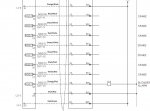I would argue that not wiring per the prints will increase your liability if something goes wrong. Yes, it is prudent to question things that don't look right, but to install things because that's how you think it should be defeats the purpose of paying someone to design the system and draw up prints.
I would agree it would increase your liability.
Most engineers I've dealt with are open to questions and suggestions particularly from site installer because there are times, whether its other trades or structure issues arise, where "as drawn" either don't work or are in conflict. They will as gadfly56 indicated will amend drawing, if deemed necessary. Large projects will have many engineers doing drawings on different aspects not just one and sometimes I've seen them not in sinc ie hvac/electrical, plumbing/electrical, structural/electrical. (Had one where structual had a door in a space electrical showed a switch, project had hundreds of pages of prints, even though we had overlays for comparison, things got missed.)
Important particularly on large projects where many levels of inspections will take place, all referring to the prints and engineering specs. The CO for building could be held up in event of nonconforming installations, not to mention non issuance of an insurance policy. I've been involved with a larger project where an insurance inspector also showed on site occasionally, (in addition to the AHJ and Building inspector), seeming to check on compliance to engineering.



